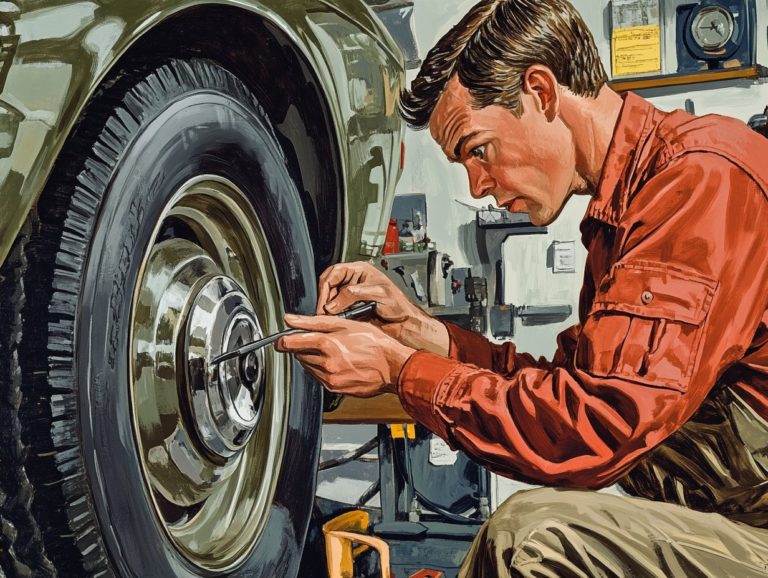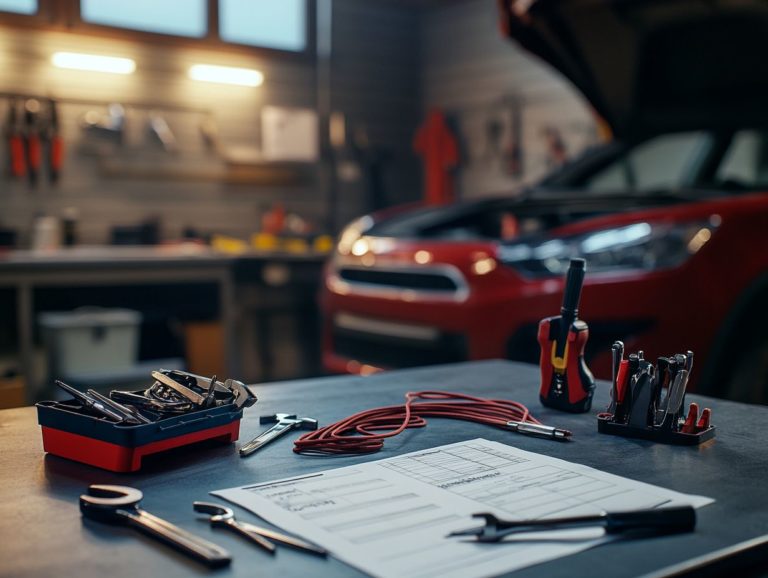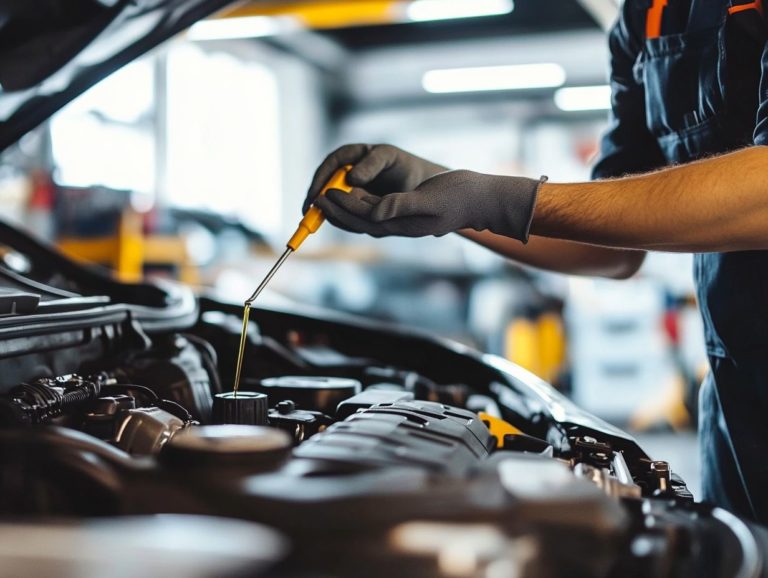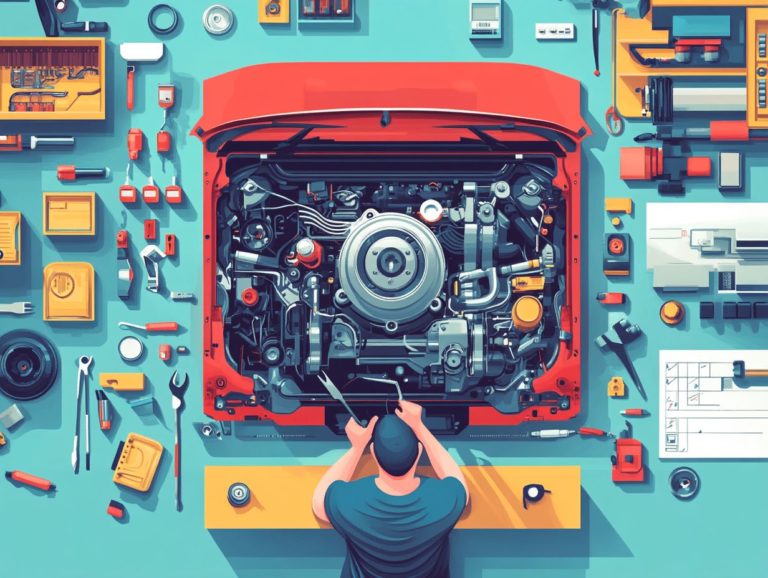The Ultimate Car Maintenance Checklist
Ensuring your car remains in impeccable condition is paramount for safety, performance, and longevity.
Engaging in regular maintenance not only elevates your driving experience but also spares you from potentially costly repairs in the future. This simple car maintenance checklist encompasses everything from tire inspections to battery evaluations.
Regardless of whether you’re an experienced car aficionado or a first-time owner, these insights will guarantee your vehicle stays both reliable and efficient.
Dive in to uncover the secrets to keeping your car running seamlessly.
Contents
- Key Takeaways:
- 1. Check Your Tires
- 2. Inspect Your Brakes
- 3. Change Your Oil Regularly
- 4. Replace Air Filters
- 5. Check and Top Off Fluid Levels
- 6. Test Your Lights and Signals
- 7. Check and Replace Wiper Blades
- 8. Inspect Belts and Hoses
- 9. Check Battery and Connections
- 10. Examine Suspension and Steering
- 11. Test Your Heat and AC
- 12. Inspect and Replace Spark Plugs
- 13. Check and Replace Fuel Filter
- 14. Inspect and Replace Timing Belt
- 15. Visit a Professional Mechanic for Regular Maintenance
- Frequently Asked Questions
- What is The Ultimate Car Maintenance Checklist?
- Why is it important to follow The Ultimate Car Maintenance Checklist?
- How often should I use The Ultimate Car Maintenance Checklist?
- What tasks are included in The Ultimate Car Maintenance Checklist?
- Can I perform The Ultimate Car Maintenance Checklist myself?
- What are the consequences of not following The Ultimate Car Maintenance Checklist?
Key Takeaways:
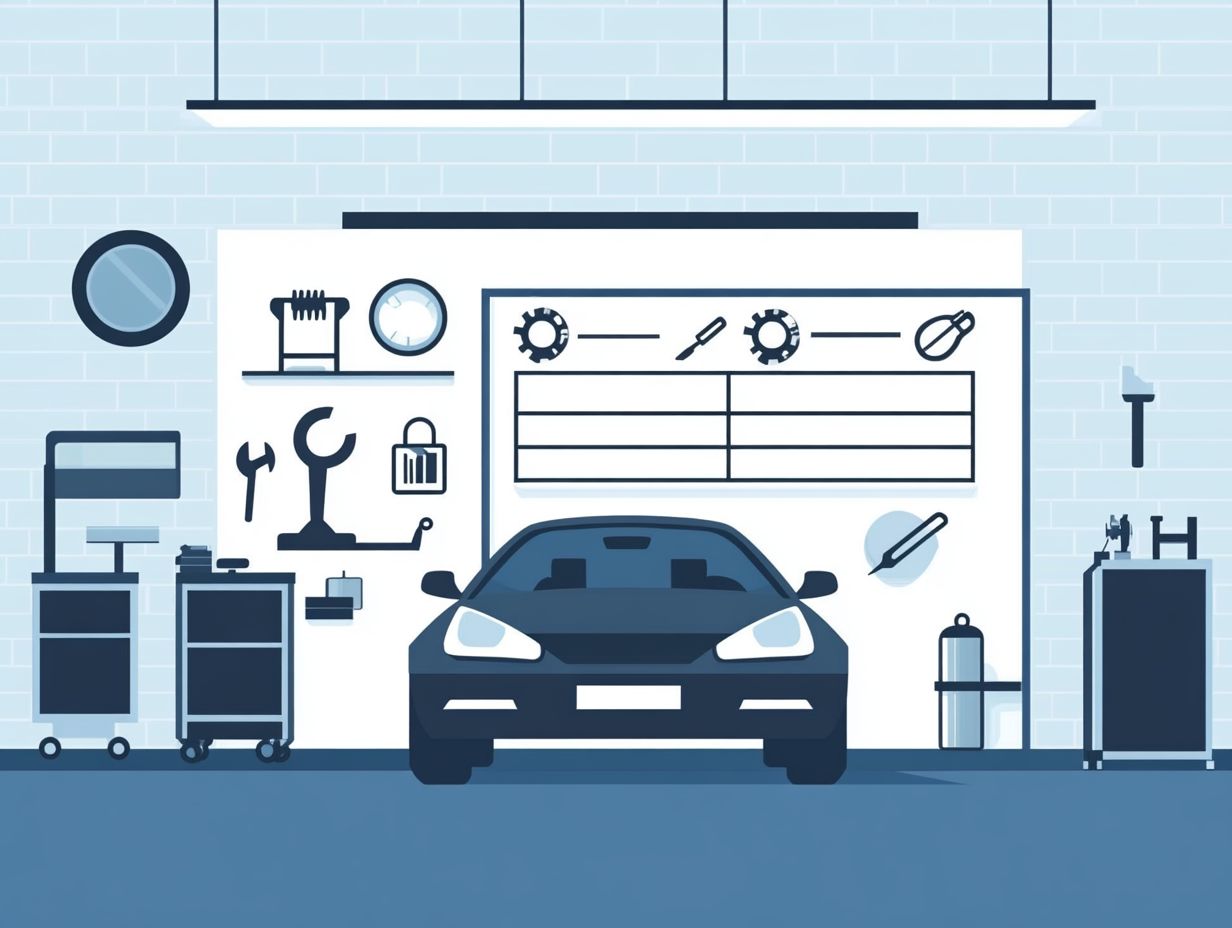
- Regular maintenance is crucial for your car’s performance and longevity.
- Don’t neglect your tires, brakes, and fluid levels for safe driving.
- Schedule regular check-ups with a mechanic to catch issues early.
1. Check Your Tires
To ensure your vehicle s performance and safety, it’s essential to regularly check your tires. Proper tire pressure and tread depth can significantly influence handling, fuel efficiency, and overall driving safety especially in varying conditions like winter or summer roads.
Use a tire pressure gauge to maintain the optimal pressure levels recommended by the manufacturer. This boosts your fuel economy and minimizes wear and tear on your tires.
Regularly inspecting tread depth is crucial for ensuring traction, particularly in wet or snowy conditions where insufficient tread can lead to hazardous driving situations.
Performing routine tire rotations helps distribute wear more evenly across all four tires, ultimately extending their lifespan. For summer tires, keep an eye out for heat-related damage, while winter tires warrant a closer inspection for signs of cracking due to cold weather.
Follow these essential tips now to keep your car running at its best!
2. Inspect Your Brakes
Regularly inspecting your brake system is essential for your safety. Worn brake pads can reduce stopping power, raising the risk of accidents and negatively impacting your vehicle’s overall performance.
To ensure your braking system operates effectively, checking the brake fluid levels is crucial. These levels are vital for the system that helps your brakes work; low fluid can result in a spongy brake pedal and compromised stopping ability.
Don t overlook the condition of your brake rotors and calipers either wear and tear here can significantly affect braking efficiency. A thorough inspection checklist is invaluable for you as a driver. It helps identify issues before they escalate.
Taking action now boosts your safety and helps your brakes last longer!
3. Change Your Oil Regularly
Changing your engine oil regularly is vital for maintaining your vehicle’s longevity and performance. Fresh oil lubricates the engine components, reduces friction, and helps prevent potential engine issues that can arise from neglect.
Adhering to the recommended oil change intervals outlined in your maintenance schedule is essential for optimizing engine health. High-quality engine oil not only improves lubrication but also contains additives that combat sludge buildup, which can lead to overheating and decreased efficiency.
By choosing a reliable service shop for your oil and filter changes, you can be confident that you’re receiving quality products and expert care. Incorporating simple preventive maintenance tips, such as regularly checking fluid levels and monitoring the condition of your oil, will further extend your engine’s lifespan and promote smoother operation.
4. Replace Air Filters
Replacing your engine and cabin air filters is crucial for achieving optimal vehicle performance. Clean filters improve airflow and enhance your engine’s efficiency while providing fresh air inside the cabin.
The engine air filter filters out dirt and debris from the outside air. This is vital for maintaining engine longevity and fuel efficiency. Neglecting to replace this filter can reduce performance and increase fuel consumption.
The cabin air filter cleans the air circulating within your vehicle, capturing allergens, dust, and pollutants. Most vehicle manuals recommend checking these filters every 12,000 to 15,000 miles. Replacement is necessary based on your driving conditions.
Skipping this essential maintenance can lead to diminished air quality and potential strain on your engine, resulting in costly repairs.
5. Check and Top Off Fluid Levels
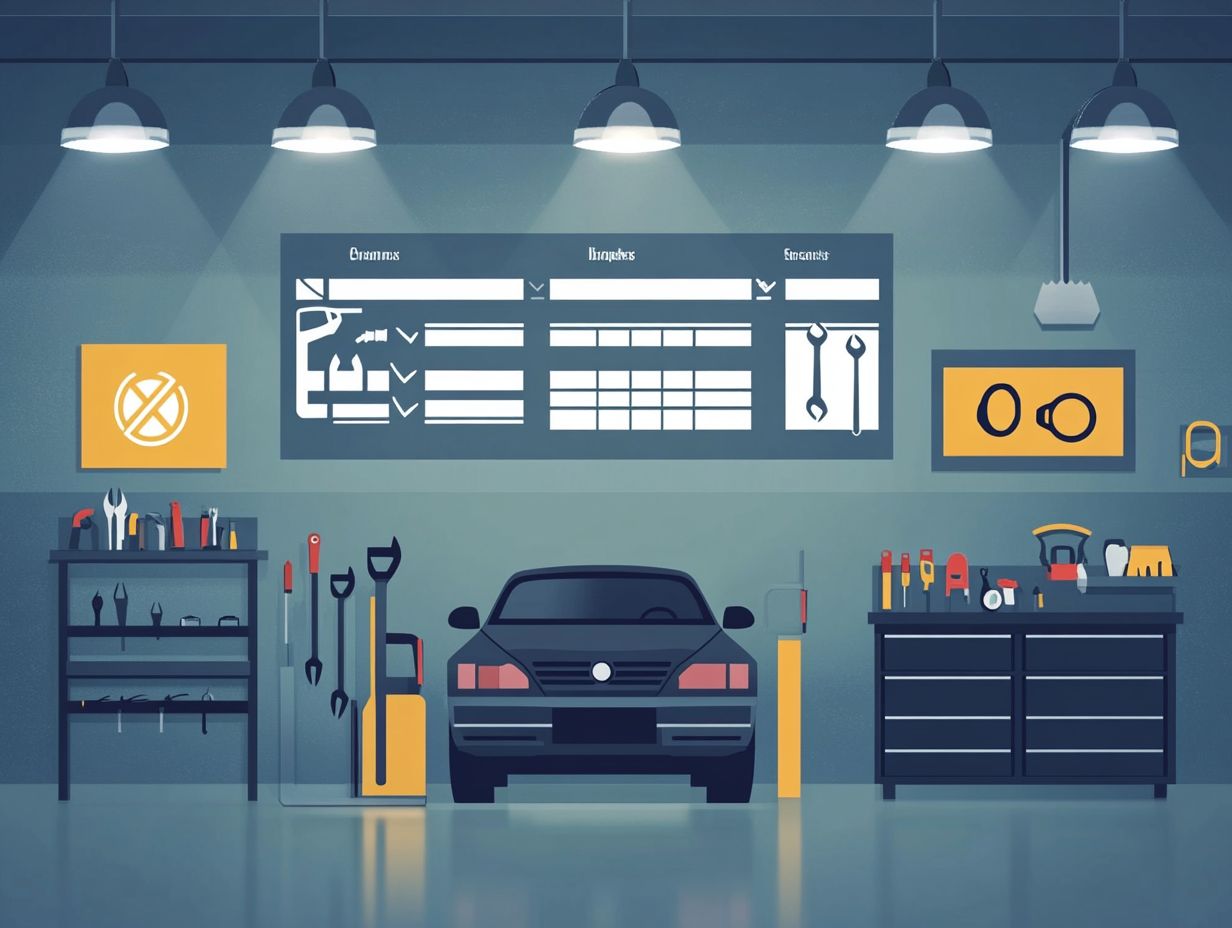
Regularly checking and replenishing your fluid levels such as coolant, power steering fluid, and brake fluid is crucial for your vehicle s performance. Inadequate fluid levels can lead to significant issues.
Familiarize yourself with specific intervals for checking these fluids. For instance, check the coolant at least every few months. Brake fluid might need more frequent attention, especially before long trips.
Topping off your fluids can help stave off potential breakdowns. However, knowing when to replace them entirely is equally important. Setting up maintenance reminders can help you manage fluid levels and prevent costly repairs later on.
Don t let neglect put your engine at risk! Serious issues, such as overheating, unresponsive steering, or compromised braking capability, can arise and jeopardize your safety.
6. Test Your Lights and Signals
Testing your vehicle’s lights and signals is important for your safety. Functional headlights, brake lights, and turn signals ensure you re visible on the road.
Regularly assessing these components can significantly prevent accidents and breakdowns. Start with a thorough inspection at dawn or dusk when visibility is better. Check each light individually by turning on the headlights, signal indicators, and hazard lights.
Have someone assist you to verify that all brake lights illuminate when pressed. Promptly replacing any broken bulbs is essential; even one faulty light can reduce visibility and lead to misunderstandings with other drivers.
Don’t forget to clean the lenses regularly to improve light output. Consider scheduling a checkup during oil changes to maintain optimal performance.
By following these maintenance tips, you enhance your own safety and contribute to a more secure environment on the roads for everyone.
7. Check and Replace Wiper Blades
Regularly checking and replacing your wiper blades is crucial for maintaining clear visibility in rainy or snowy conditions. Worn blades can severely impair your ability to see the road and heighten the risk of accidents.
Perform a visual inspection of your wiper blades at least once a month. Look for signs of wear like cracks, splits, or fraying along the rubber edges. If you notice streaks or missed spots, it s time to replace them.
In addition to these checks, consider setting up maintenance reminders to stay on top of this essential task. A simple calendar alert or reminder app can help ensure your blades are swapped out before they become a hindrance.
8. Inspect Belts and Hoses
Regularly inspecting your belts and hoses is essential for preventing engine issues. Worn or damaged belts can lead to engine failure, while compromised hoses may cause coolant leaks that could ultimately harm your vehicle.
These checks not only keep your vehicle running smoothly but also help you identify potential problems before they escalate into costly repairs. During a visual inspection, look for noticeable cracks, fraying, or glazing on the belts, and ensure they re properly tensioned.
For the hoses, keep an eye out for bulges, leaks, or soft spots. These signal wear that could compromise their integrity. By adding these inspections to your routine maintenance checklist, you not only save money but also extend the lifespan of your engine components, ensuring your vehicle remains in optimal condition.
9. Check Battery and Connections
Don t risk being stranded! Regularly check your battery and connections to stay ahead of any surprises. A failing battery can lead to those dreaded unexpected breakdowns, and loose connections can really throw a wrench in your electrical efficiency.
Regularly assessing your battery’s performance can help you catch issues early, ultimately saving you time and money. Don t overlook the importance of cleaning the battery terminals; corrosion can block the flow of electricity and lead to more significant problems down the road.
A comprehensive inspection should include not just checking the charge level, but also evaluating the overall condition of the battery and cables. If you find yourself uncertain or feeling overwhelmed by maintenance, consulting a service technician for a professional evaluation can be invaluable.
They can provide personalized maintenance tips that will help extend your battery’s lifespan, ensuring your vehicle stays in peak condition.
10. Examine Suspension and Steering
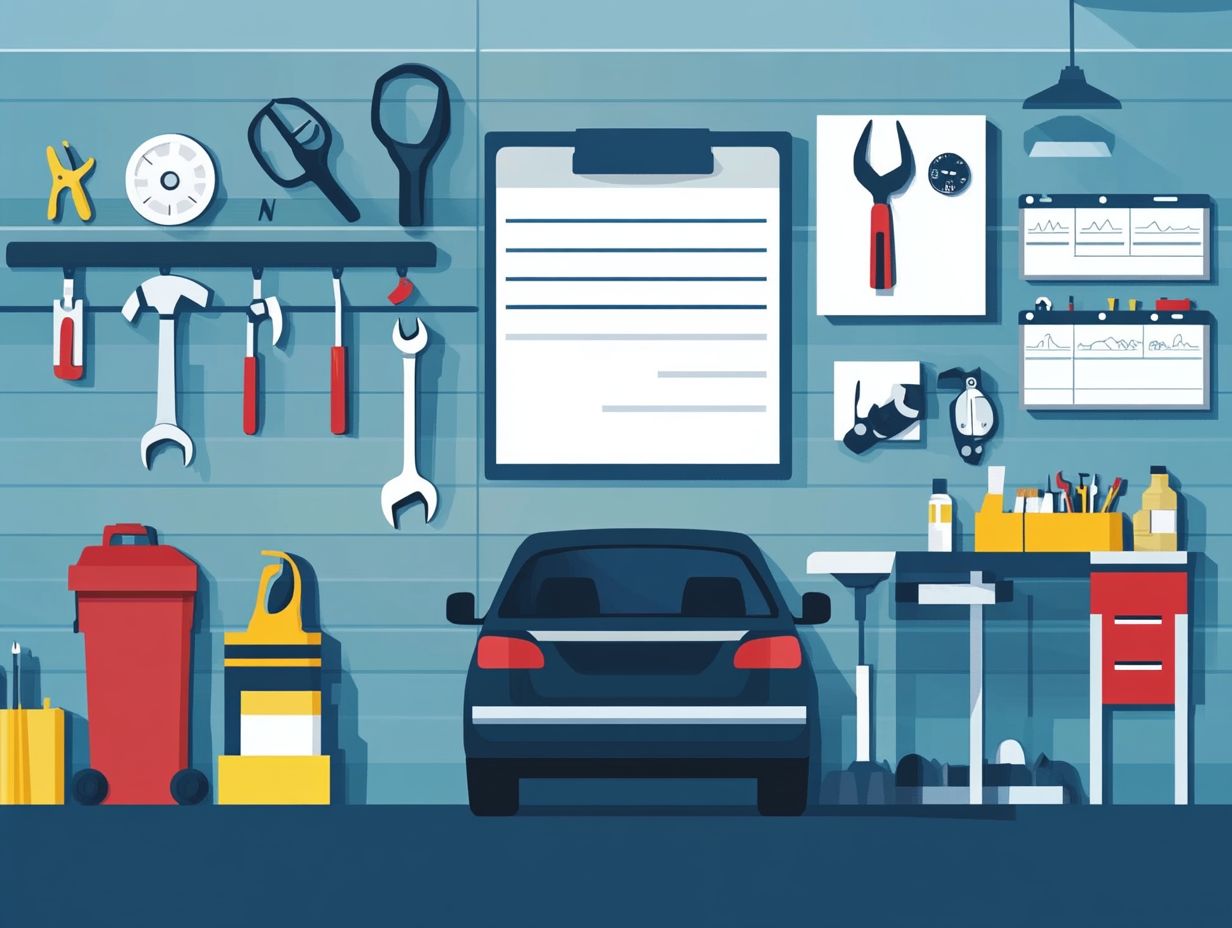
Examining your vehicle’s suspension and steering system is crucial for ensuring safe handling and ride comfort. Worn components can significantly compromise vehicle control and accelerate tire wear, ultimately affecting overall performance.
To start, conduct a thorough inspection by checking for visible signs of wear or damage in the suspension components, including bushings (rubber cushions that support parts of the suspension), shock absorbers, and struts. Look out for rust, cracks, or leaks that may signal a failure or jeopardize the system’s integrity.
Regarding the steering system, assess the tie rods and power steering fluid levels to confirm everything is functioning as it should. Keeping a detailed inspection checklist provides a maintenance record that helps identify any recurring issues that could worsen if neglected.
Regular maintenance of these systems is essential for preserving your vehicle’s safety and performance.
11. Test Your Heat and AC
Testing your vehicle’s heating and air conditioning systems is essential for ensuring your comfort, as efficient climate control significantly enhances your driving experience especially during those sweltering summers or frigid winters.
By regularly checking the functionality of these systems, you not only create a pleasant cabin environment but also identify potential issues before they have a chance to escalate. To give it a good check, start by running each system separately; listen for any unusual sounds and check for proper airflow from the vents.
If the temperature isn t adjusting as expected or if you detect a strange odor, these could be red flags indicating underlying problems. It’s essential to schedule routine maintenance checks at least once a year. This proactive approach allows you to address minor repairs before they transform into costly fixes, ensuring smooth operations no matter the season.
12. Inspect and Replace Spark Plugs
Inspecting and replacing spark plugs is crucial for achieving optimal engine performance. When spark plugs become worn or faulty, they can lead to misfires, lower fuel efficiency, and various engine complications.
It’s imperative to regularly examine your spark plugs for signs of wear. Look out for excessive carbon buildup, cracking, or erosion on the electrode surface. Following the manufacturer s maintenance schedule typically every 30,000 to 100,000 miles depending on your vehicle ensures that you maintain peak engine health.
If you don t replace worn spark plugs, it can cause poor combustion, forcing your engine to work harder and consume more fuel. This can ultimately compromise your vehicle s performance and longevity. A quick inspection can save you from more extensive repairs down the line and significantly enhance your driving experience.
13. Check and Replace Fuel Filter
Regularly checking and replacing your fuel filter is crucial for maintaining optimal engine performance. A clogged filter can restrict fuel flow, leading to inefficiencies and potential engine issues.
To determine if your fuel filter needs replacement, keep an eye out for several warning signs. You should pay attention if you experience difficulties starting the engine, a noticeable decrease in acceleration, or a loss of power while driving.
If your vehicle stalls or hesitates during acceleration, those could very well be linked to a failing filter. Follow the recommended maintenance schedule outlined in your vehicle s owner manual to ensure optimal fuel system performance.
Regular inspections and changes every 15,000 to 30,000 miles are advisable, though this may vary depending on your driving conditions and vehicle type.
14. Inspect and Replace Timing Belt
Inspecting and replacing the timing belt according to your maintenance schedule is essential for preventing serious engine problems. A worn or broken timing belt can lead to major failure, which is a scenario you definitely want to avoid.
To ensure its longevity, keep an eye out for visible signs of wear, such as fraying, cracks, or any unusual looseness. It’s wise to consult your vehicle’s owner manual for specific replacement intervals, which typically range from 60,000 to 100,000 miles depending on your make and model.
Neglecting this important part could result in serious engine problems, including bent valves or extensive repairs that can drain your wallet and time. Regular inspections and timely replacements can spare you the stress of unexpected breakdowns and costly repairs, allowing you to enjoy the road with peace of mind.
15. Visit a Professional Mechanic for Regular Maintenance
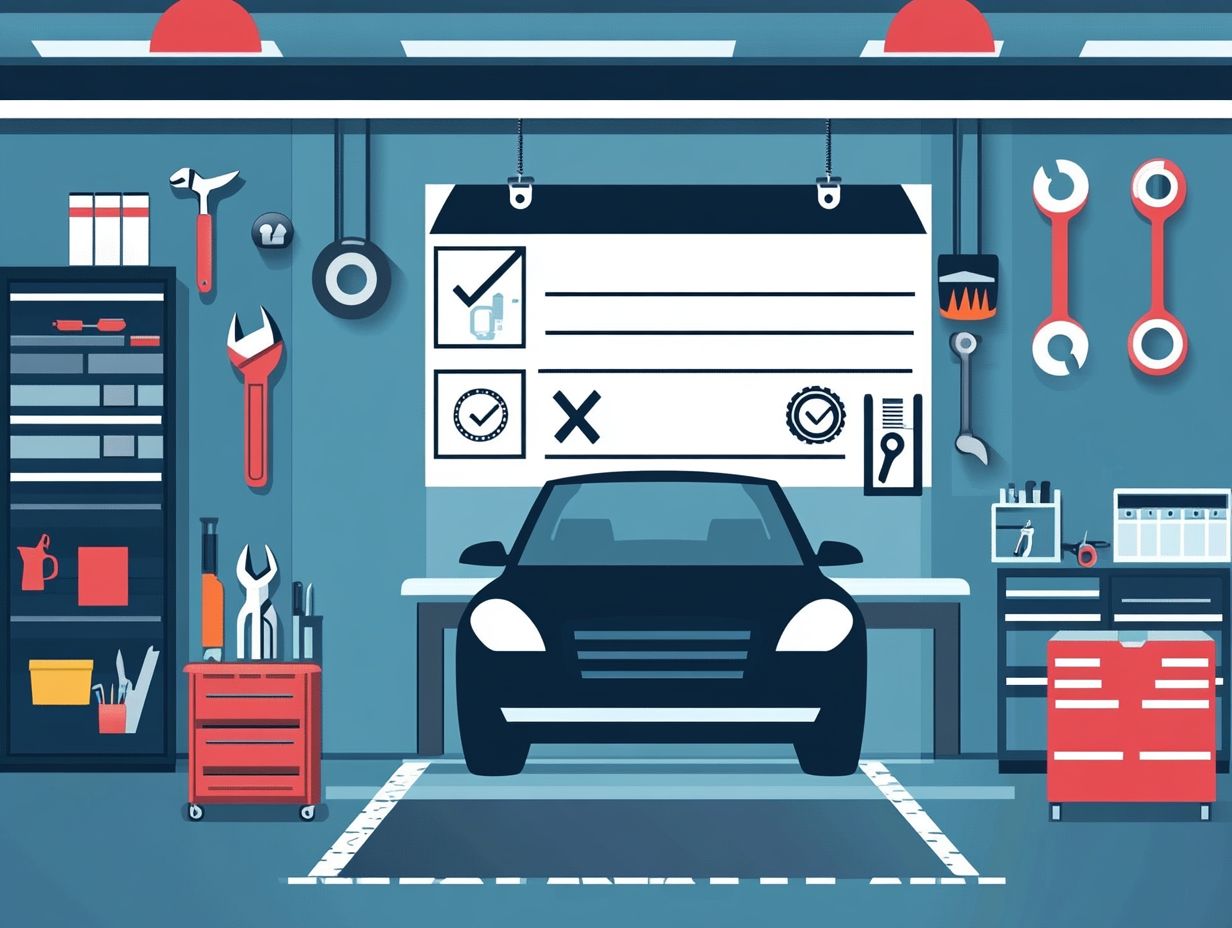
When you visit a professional mechanic for regular maintenance, you ensure that your vehicle receives the care it needs to operate safely and efficiently. Experienced service technicians can spot potential issues before they turn into expensive repairs.
This proactive approach includes a range of services think oil changes, tire rotations, brake inspections, and fluid replacements all designed to boost your vehicle’s performance. By addressing the wear and tear on essential components, you can enhance fuel efficiency and enjoy a smoother driving experience.
Regular check-ups give you peace of mind and help your vehicle last longer! Building a relationship with a trusted service shop means you benefit from personalized service, where the specific needs of your vehicle are carefully monitored and tailored to keep it in top shape.
Frequently Asked Questions
What is The Ultimate Car Maintenance Checklist?
The Ultimate Car Maintenance Checklist is a comprehensive list of tasks that should be performed regularly to keep your car in top condition. For a detailed approach, refer to the ultimate checklist for seasonal car maintenance, which includes everything from basic maintenance like oil changes to more detailed inspections and repairs.
Why is it important to follow The Ultimate Car Maintenance Checklist?
Regular maintenance using the ultimate guide to car maintenance schedules can help prolong the life of your car, prevent breakdowns, costly repairs, and ensure your safety while driving.
Start your vehicle maintenance journey today check your spark plugs and fuel filter!
How often should I use The Ultimate Car Maintenance Checklist?
Use The Ultimate Car Maintenance Checklist at least once every three months or every 5,000 miles, whichever comes first. To help you stay on track, consider these top 10 car maintenance tips for beginners. You might need to do some tasks more often based on how you drive and your car’s condition.
What tasks are included in The Ultimate Car Maintenance Checklist?
Some tasks include checking and changing fluids, inspecting tires, and replacing filters. You ll also want to test lights, signals, and keep your car clean and waxed.
Can I perform The Ultimate Car Maintenance Checklist myself?
Many tasks on The Ultimate Car Maintenance Checklist can be done by car owners. Just follow instructions carefully and use the right tools, and remember what every driver should know about maintenance.
What are the consequences of not following The Ultimate Car Maintenance Checklist?
Skipping the Ultimate Car Maintenance Checklist? Your car might not perform well and could pose safety risks. To avoid this, consider following the top 10 car maintenance tips for longevity. This can help prevent costly repairs or even the need to buy a new car sooner than expected.


